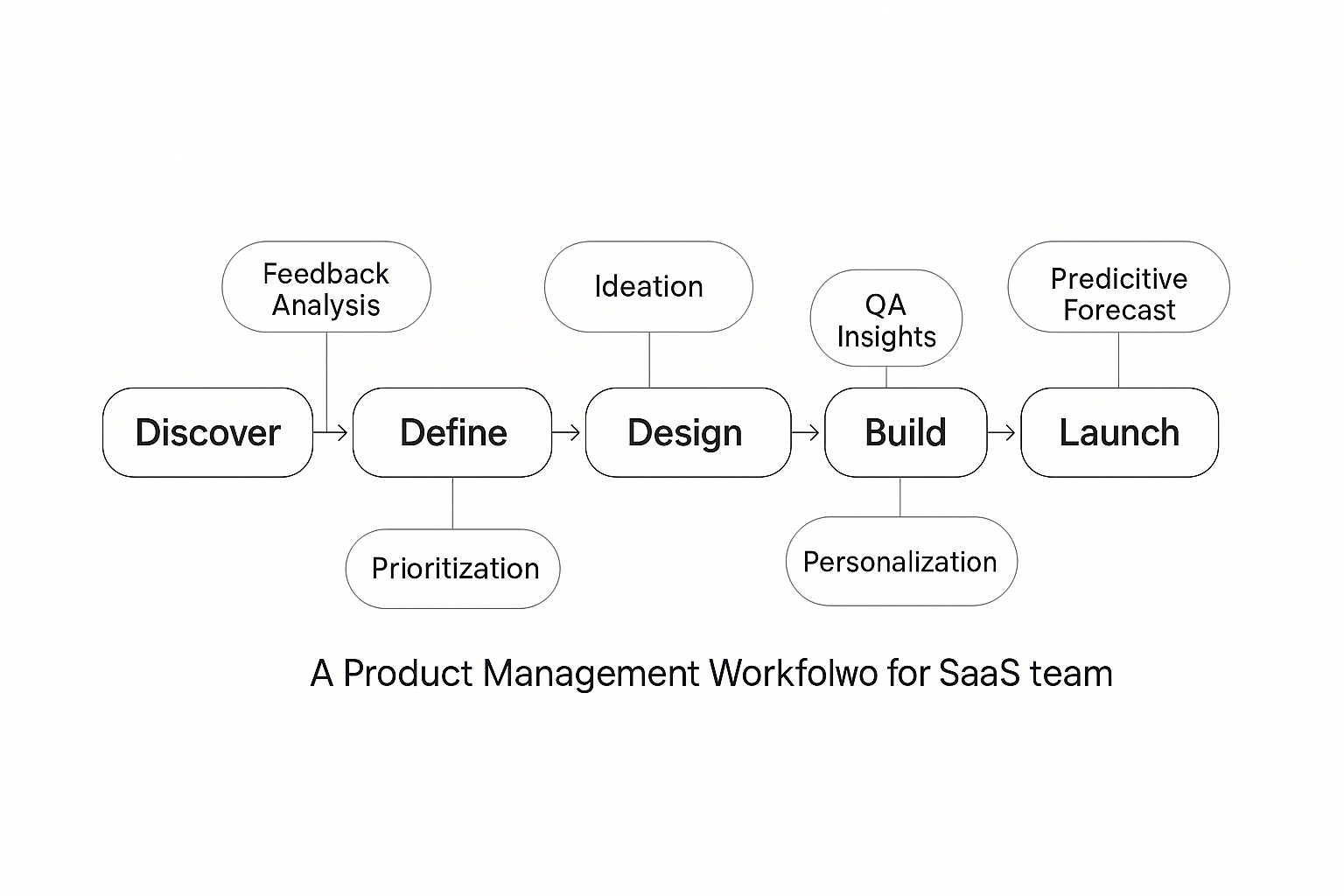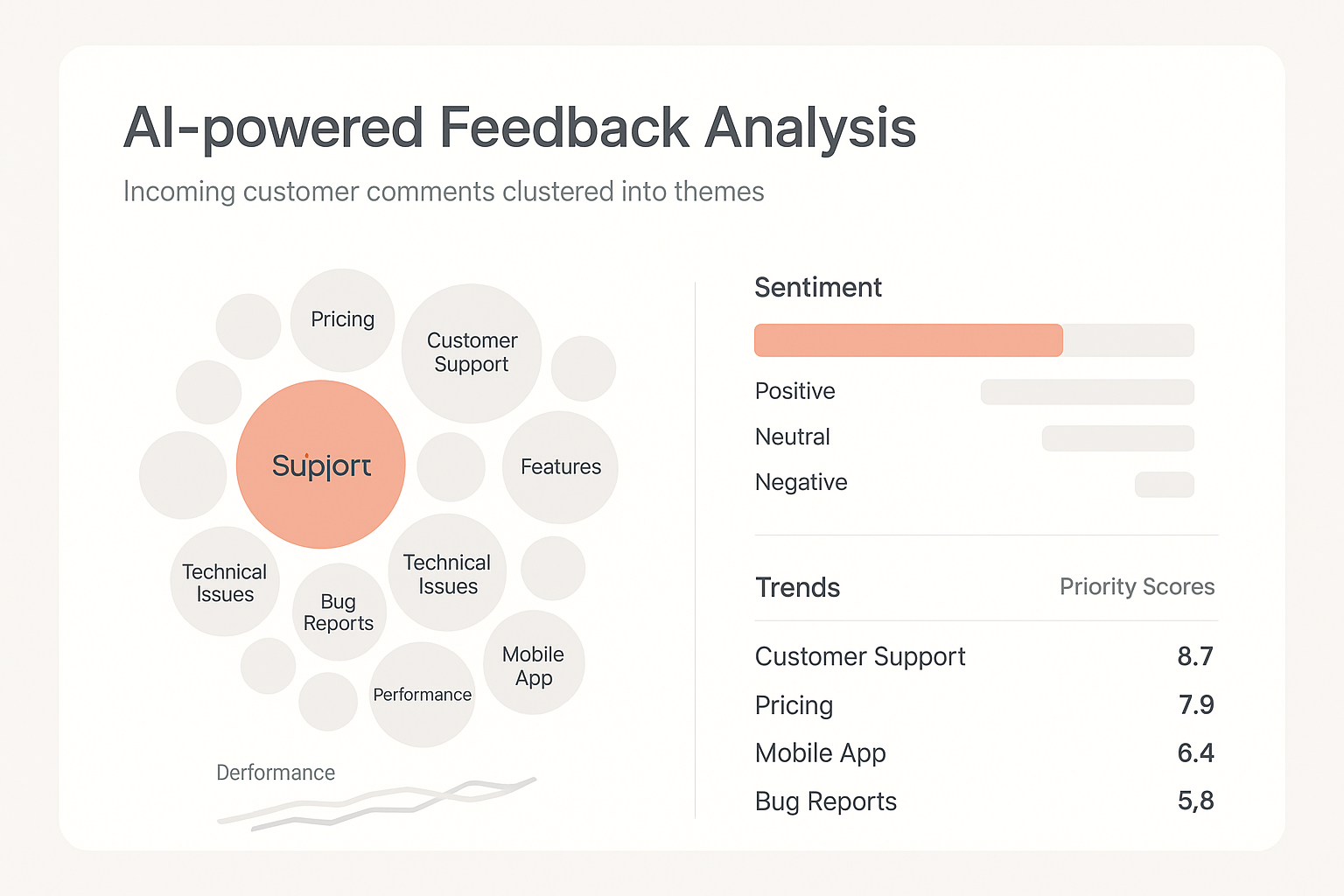# Why AI in product management now
AI in product management is not about replacing judgment. It is about clearing noise so PMs can spend time on strategy. Modern AI fits across the lifecycle, from discovery to launch, and it keeps improving with your data.
We have seen teams use AI to shorten feedback analysis from weeks to hours, cut busywork, and de-risk bets. The pattern is simple: automate the routine, elevate the decisions.

# Core use cases to ship with clarity
# Customer insights and feedback analysis
AI platforms cluster comments, tag themes, and surface sentiment across channels. That turns a noisy inbox into a map of problems and demand. You can triage 10,000 comments, spot an onboarding drop-off, and push a fix inside a sprint.
- Aggregate feedback from email, support, and social, then auto-tag by topic and persona.
- Highlight emerging pain points, for example “login errors on mobile after 2FA.”
- Translate signal into action, like prioritizing a workflow overhaul over a new widget.
For a broad scan of tools and patterns, see Product School’s overview of AI tools for PMs, Chisel’s roundup of best AI tools, and Motion’s guide to AI for PMs:
- https://productschool.com/blog/artificial-intelligence/ai-tools-for-product-managers (opens new window)
- https://chisellabs.com/blog/top-ai-tools-for-product-managers/ (opens new window)
- https://www.usemotion.com/blog/ai-tools-for-product-managers.html (opens new window)
# Ideation and prototyping
Use AI to explore concepts fast, then validate. Chat-based systems draft user stories and acceptance criteria. Design tools convert prompts into screens, which you refine with your design sense.
- Generate story maps from a goal and a few constraints.
- Produce clickable prototypes, then run micro-tests the same day.
- Keep a human in the loop to ensure taste and fit, not just speed.
A concise tour of workflows is in ProdPad’s guide to AI tools for PMs: https://www.prodpad.com/blog/ai-tools-for-product-managers/ (opens new window)
# Productivity and automation
Your calendar and backlog are full of repetitive tasks. AI can summarize meetings, extract action items, and draft PRDs and status notes that you finalize.
- Auto-summarize research calls, attach highlights to backlog items.
- Draft PRDs or release notes, then polish the narrative and edge cases.
- Keep the roadmap current without manual status wrangling.
# Predictive analytics for decisions
Predictive models analyze cohorts and behavior to forecast demand or churn risk. They help quantify impact before you commit resources.
- Forecast adoption for a pricing change or new tier.
- Simulate roadmap scenarios, then choose the least risky path.
- Pair model output with product intuition, do not outsource judgment.
# Product development and testing
AI helps triage bugs and recommend sprint priorities. Post-launch, it flags drop-offs and adoption cliffs by segment.
- Detect duplicate issues and cluster them by root cause.
- Suggest sprint focus based on issue volume trend and feature performance.
- Set a working SLA, for example critical bugfixes within 7 days.
# Personalized user experiences
Machine learning adapts content and features per user. Done right, personalization feels invisible, like a product that already knows you.
- Recommend features to activate based on time to value.
- Adjust onboarding by role, company size, or user intent.
- Measure uplift with holdouts, not just vanity metrics.
# Recommended AI tools for PMs, by job to be done
You do not need a mega-suite on day one. Start with tools that fit your team and stack. Four useful references:
- Product School’s landscape: https://productschool.com/blog/artificial-intelligence/ai-tools-for-product-managers (opens new window)
- Chisel’s tool guide: https://chisellabs.com/blog/top-ai-tools-for-product-managers/ (opens new window)
- Motion’s roundup: https://www.usemotion.com/blog/ai-tools-for-product-managers.html (opens new window)
- ChatPRD for fast PRD drafting and coaching: https://chatprd.ai (opens new window)
Practical pairings we have seen work:
- Discovery and insights: feedback clustering plus sentiment tagging, then human review for nuance.
- Docs and coaching: a PRD-drafting copilot to get from outline to 80 percent, you finish the last mile.
- Delivery: meeting summaries, action items, and status digests that tie back to Jira and Slack.
# Implementation playbook, not just a wishlist
# 1) Select fit-for-purpose tools
Map needs to tools, not the other way around. Prioritize integrations, data access, and your team’s comfort.
# 2) Integrate with your systems
Connect to Jira, Slack, and your data warehouse. Eliminate copy paste. Tighten permissions.
# 3) Train the team
Run short workshops. Show real examples from your product. Create templates for PRDs, experiments, and release notes.
# 4) Set guardrails for data security
Define what data can be shared, who can view model outputs, and how to audit changes.
# 5) Keep humans in the loop
Schedule reviews for AI summaries and forecasts. Require an owner to accept or reject each suggestion with a reason.
# 6) Stay customer centric
Close the loop with real users often. Validate insights before scaling a decision.
# Where Sleekplan fits
If feedback is your raw material, you need a clean pipeline. Sleekplan helps teams capture, structure, and act on customer feedback in one place, from public boards to in-app widgets and release notes. See what it looks like in our feature tour: https://sleekplan.com/features/ (opens new window)

With a structured feedback layer, you can safely add AI on top to summarize themes, track sentiment by segment, and align roadmap choices with what customers actually ask for.
# Limitations and what to watch
- Large datasets may strain some tools, and custom reporting can be limited. Start scoped, then scale.
- All-in-one platforms come with a learning curve. Roll out in phases, expand as proficiency grows.
- General assistants are helpful, but they do not replace domain tools. Combine them to cover depth and breadth.
# FAQ: fast answers for busy PMs
What is AI in product management? It is the use of machine learning and language models to analyze feedback, draft docs, forecast outcomes, and personalize experiences so PMs can focus on decisions.
Which AI tools are best for PMs? Start with a feedback analyzer and a doc assistant. Add predictive analytics when your data is clean and connected. Useful sources: Product School, Chisel Labs, Motion, and ChatPRD.
How do I measure impact? Track time saved per task, cycle time for discovery and delivery, decision quality, and user outcomes like activation and retention.
Where should I start? Pick one workflow with repetitive work, for example research synthesis. Pilot, measure, then scale.
# The principle that holds
Quality beats speed when the choice is forced, but AI lets you keep both if you respect the craft. Use it to remove friction, keep humans accountable, and make better calls with clearer context.